After the December 16 snowstorm, there was a lot of media coverage and comment about how poorly snow was cleared for pedestrians compared to drivers (cyclists were also poorly served).
There are three primary problems:
– the road ploughs leave huge piles of snow at intersections and transit stops, which pedestrians then have to climb over;
– when the snow starts melting, large pools of salty water that are difficult to cross accumulate at intersections because sewer grates are left blocked with snow; and
– where the city doesn’t plough sidewalks, many residents and businesses neglect their obligation to shovel, leaving narrow and slippery packed snow.
These are problems for everyone (slips and falls are a primary cause of injuries for pedestrians, and these issues also increase the risk of being hit by cars), but they are particularly dangerous for anyone with mobility problems, and for people with children, who end up essentially shut in after a storm.
At the January 22 meeting of the Toronto Pedestrian Committee, we put the issue on our agenda and submitted a report to Works Committee (which is on the agenda (PDF) for their meeting this Friday, Feb. 8 ) outlining these problems and providing a series of recommendations for addressing them.
We also heard from a manager from Transportation Services at the City. Apparently the city is at the moment working on a review of snow clearing that includes improving snow clearing for pedestrians. I went out walking yesterday (Feb. 2) after the Feb. 1 storm, and I could see that the City has started to respond to the concerns expressed by pedestrians, and there were in fact some attempts to clear snow for people on foot more effectively. But the attempts are still haphazard — the primary goal of the pedestrian committee recommendations was to make snow clearance for pedestrians more systematic and co-ordinated.
Here are some visual notes about what’s been done and what’s still to do.
The most visible improvement was that the City, within a day of the storm, was clearing a wide path at intersections on major streets, including the sewer grate so that there was no pooling of water. Here are examples from Spadina and Harbord (where you can see the snow has been pushed to a huge pile on the left where it’s not in anyone’s way), and from Queen and John.
However, even when clearing a wide path the ploughs still missed the sewer grate at several points, leaving difficult pools of water. Here is Queen and Peter.
At Queen and University, although the street corners were cleared, the median was left uncleared, leaving a hazardous pool of slush and brine to cross.
While some TTC stops were cleared, others were left blocked. This is the important transfer stop between the College streetcar and Queen’s Park subway, at 1:30 pm on the day after the storm. You can see how many people have already had to cross it, two narrow foot-wide paths have been beaten down.
While one might say that you can’t expect everything to be cleared at once, in fact that’s exactly what we should expect. The key recommendation the pedestrian committee sent to Works is that sidewalk clearing should be co-ordinated with street clearing. The little sidewalk ploughs should run the same routes as the street ploughs, immediately after them, so that transit stops, intersections and sidewalks should be cleared of the snow piles as soon as these piles are created — and this kind of situation doesn’t happen. It simply means treating pedestrians equally to cars.
We heard an even more intriguing possibility at the pedestrian committee meeting, too. One of our members pointed out that, in Montreal, streets are cleared of snow completely all at once. The city can enforce a temporary “no parking” policy along important streets designated as “snow routes”, giving notice for cars to be cleared, and then the city goes in with road and sidewalk ploughs at once, followed by those massive snow-blowers dumping the piles into trucks to be taken away (and now there are snow-melting trucks too — I believe Toronto even has a couple of them). In the end, there are no piles of snow anywhere along the street.
We were surprised to be told by staff that, in fact, such snow routes are designated on some streets in Toronto as well, and can be activated if the mayor declares a “snow emergency.” We recommended that this provision should be activated and enforced much more often. It would make things easier for everyone, but the biggest difference would be to clear routes for cyclists.
Finally, of course, there’s the problem of people not clearing snow from the sidewalk in front of their property. I think that more sidewalks, at least on major roads, should be ploughed by the city, but in the absence of city ploughing, it’s a law that needs to be enforced. Here, for example, is the sidewalk outside the CIBC bank at Queen and Spadina.
The bank has cleared and salted the snow in front of the entrance, but the wide sidewalk along Queen — which sees some of the heaviest pedestrian traffic in the city — has been left unshovelled, becoming packed down and slippery. I know CIBC has suffered a drop in profits this year, but I’m sure in their multi-billion dollar budget they could find a few hundred dollars to hire someone to clear their full sidewalk even on days they’re not open, so that they are in compliance with local bylaws. Surely it’s worth their while just to avoid the danger of getting sued?

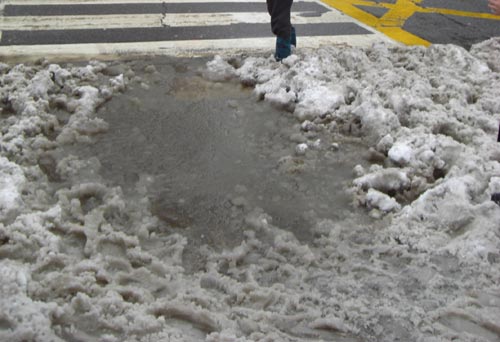
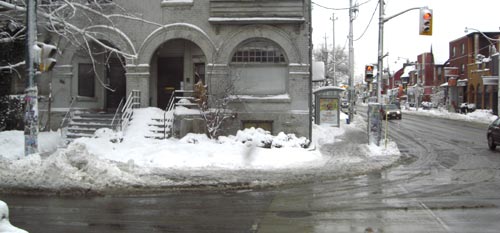
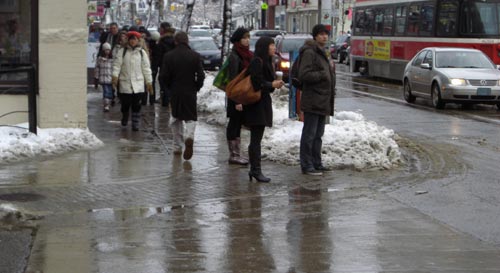
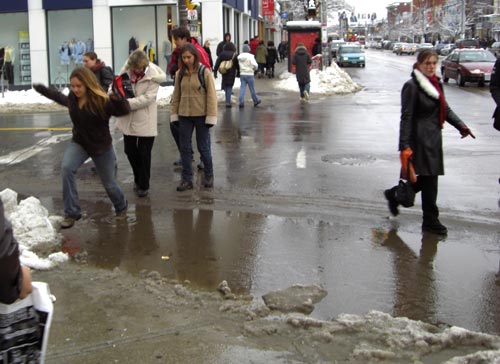
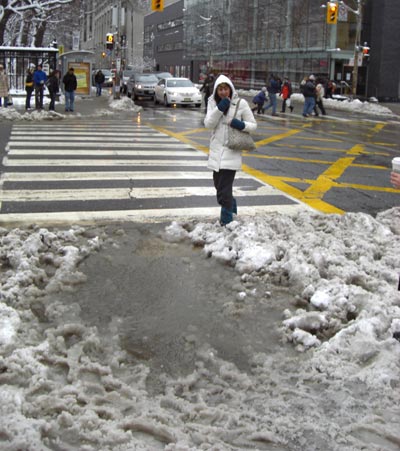
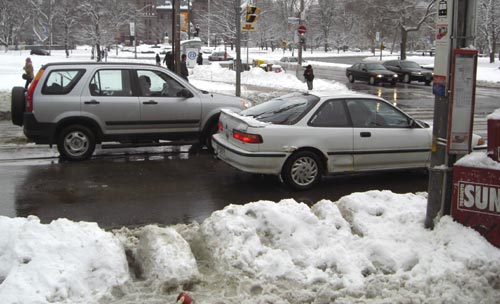
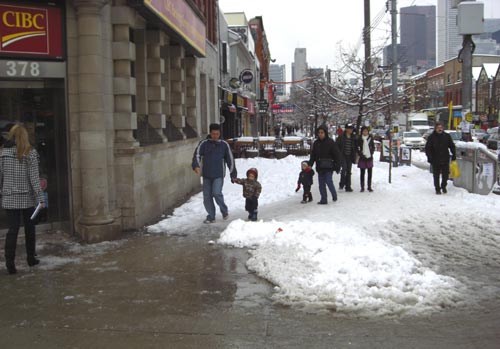
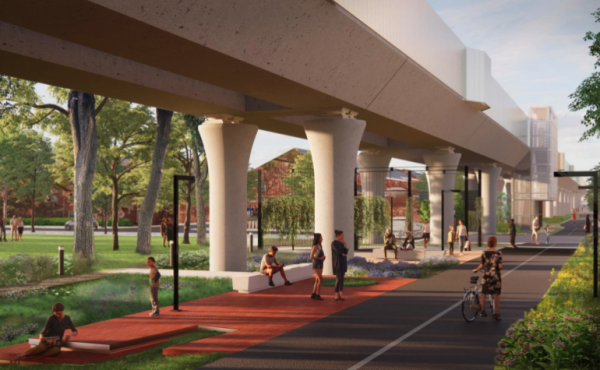
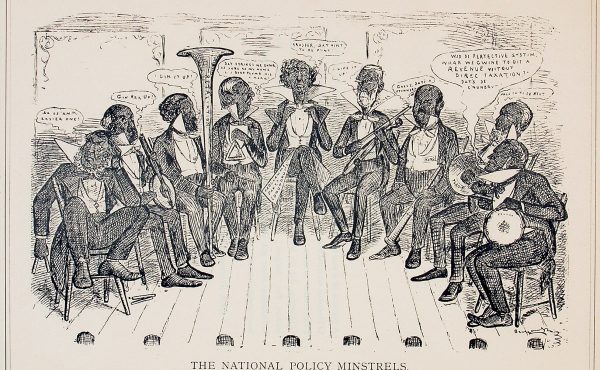

28 comments
Excellent post, and timely. Can you imagine the state of our sidewalks if we did not get such regular meltings in Toronto? I was in Montreal a dozen years ago, and even when that city was far poorer than Toronto, the streets were walkable. It’s an issue of whether a culture believes in society or not. For the past couple of decades tory Ontario took Thatcher’s horrid notion to heart: “There is no such thing as society”. I am glad we have social-democratic Quebec in the bosom of the nation, lest things get even worse than they are.
Hi. I’d suggest that the Toronto Pedestrian Committee look closely at the snow clearing activities and bylaws in Edmonton, Alberta. There, all property owners are required to clear every square inch of both ice and snow off the sidewalk within 24 hours or they face a serious municipal fine, and this is enforced quite heavily; i remember a few years ago, a city councillor was even dinged for this. The municipality does not provide any sidewalk plowing at all, and yet, i neve had a problem with uncleared walks there.
Also, i remember seeing street plows driving up right onto the sidewalk to clear the area in front of transit stops. This could be easily done here too.
I don’t think this covers the situation accurately. In a dense downtown area it is reasonable that it take a little while for things to get back to normal.
However, in my suburban area the sidewalk was cleared TWICE before the almost impassable road was cleared making the situation dangerous for everyone – cars and pedestrians alike. Considering it would take 5 minutes to clear my street there isn’t much excuse. City workers with plows drove by the street at least 3 times .
The reason given by the city keeps changing and the city councillor can’t even get satisfaction. One suspects that it is a simple matter that disengaged City workers are either lazy or incompetent.
Sorry – I left this out. That is two days to clear the street. In December it was 3 1/2 days.
Thanks for the post, examples, and the pestering.
The City does fail to deliver clearing for non-motorists. It is blatantly unfair, but “carism” is alive and well.
In theory the City tries to have I think it’s a third of the bike lane blocked with snowbank, but the sad reality tends to be white line riding as they manage to only plow snow into the bike lanes, not out of them.
The TTC doesn’t help sometimes either, in their trying to clear spaces for boarding and exiting, they push the snow to either side, to muck passage up for bikes.
In the fall, (mid/Nov?) there was a claim by Mr. DeBaeremaeker that they could trim out $4M from the snowclearing and still make it safe. Sorry Glenn. That’s not happening.
It’s still lousy and dangerous – especially for cyclists, as our winters haven’t totally gone through climate change. In fact climate change does more for winter cycling than the City does.
Thanks for the tip about the Friday mtg too.
Has anyone actually been fined for not ‘clearing their ice’ as the ads used to say?
I find it maddening that the city during the financial crisis that shut our community centres and libraries down (with NO actual savings), they still found it necessary to send out trucks whose sole purpose I can conceive is to whirl street dust into cyclists’ lungs.
Those mobile vacuums? I usually see idling near a coffee shop or them barreling down the sidewalk (that must be some complex algorithm used to decide which pieces of garbage warrant vacuuming).
Ensuring safe side walks should be the first step in any ‘pedestrian strategy’ If I was slipping on cigarette butts, then we might have something to discuss … unless of course, it’s just lip service they’re after.
There’s a man who sells homeless papers outside CIBC — a very nice man, BTW. If he’s looking for cash, maybe CIBC could hire him.
james,
i’m sure it’s frustrating to see plows drive past your street, but from the perspective of a city-wide snowclearing effort, isn’t it perfectly sensible that they focus on major arteries before residential side streets? i live on a minor one-way through street in little portugal, and neither the street nor sidewalks have been cleared. our street is a low priority, as it should be. most people are polite enough to shovel and help their neighbours get unstuck if need be. i’d love better city service, but i prefer they deploy improvements in a systematic manner, as advocated in the blog post.
i would argue that the city should focus on denser, central areas first, because they deliver more bang for the buck in terms of serving the public. suburban residents carry an overhead of more road space per capita, making snowclearing inherently less efficient there. in the suburbs, early snowclearing should be closely targeted.
it’s also important to get a jump on clearing in the city centre because there’s nowhere to pile large amounts of snow (when i lived near jarvis and bloor during the great snowstorm of 1999 they used melting chambers). toronto has one of the densest central business districts in the world.
Part of the issue remains that the city has been pillaging the snow clearing budget for the past decade believing that no one would really notice. This practise has been entrenched and accellerated under the Miller administration. While governing is choosing… eventually, these decisions come home to roost.
Removing snow (and not just pushing it aside), has to be viewed as a core city service. There are efficient ways out there to clear streets and sidewalks. The city should be implementing them.
In the end, one of the few things that pedestrians and drivers agree on is that the city is not removing snow properly from anywhere and it is putting us all in harm’s way.
It should be noted that this is within the Operating Budget which is up for public comment this Tuesday at City Hall.
Ottawa also has a no-parking law for 1 a.m. to 7 a.m. following a large snowstorm, allowing the entire street to be cleared. I got a $68 ticket for not knowing this information.
Ok, a quick update. After 2 days a team of 8 guys finally cleared my street today while worshiping at the Church of the Double Time. Most small streets in Scarborough were cleared yesterday – the issue appears to be that the city does not have the equipment to handle medium-density developments (I’m located right beside a GO station).
The funny thing is – an apropos to this article – they dumped a huge 8′ pile of snow on top of the sidewalk leading out of the neighborhood.
Now the private condo development next door was cleared using a single truck on Friday, and the sidewalks over there are spotless.
However you look at it, it is fair to say that the city snow clearance isn’t working well.
I found that Church/Wellesley was the best cleared area I have walked in since the snowstorm, especially compared to the downtown financial district or anywhere on Queen Street. The pool at Queen/University, as shown above, was easily the most treacherous.
I am wondering if the BIA’s have anything to do with this, as they do in other cities?
Downtown snow clearance may not be perfect, but it could be the burbs. After the New Years snowfall, I was watching the sidewalks as I went up and down Vic Park, and no one cleared their sidewalks from the 401 down to at least Eglinton. Plaza and apartment owners will clear their driveways and parking lots, and even pathways that lead OUT to the sidewalk, but the actual sidewalks themselves didn’t get touched until the City got to them days later. In the meantime, if you’re a pedestrian, you’re on your own trudging through snow and climbing over snowbanks.
I finally got my winter bike fairly rideable, and so I was biking in the core area via Bloor. At times, it was a third cleared, maybe a bit more. Most of the rest of the times it was white line riding and on St. George and College, where there are the indented parking bays the city was quite inept and incompetent and doing Any of the indents, leaving the poor motorists nowhere else to park but in the bike lane.
To further insult and endanger cyclists, at times, the advert street trash/box furniture often had their ads obscured by snowbanks on both sides – and somebody has recently been around shovelling the ads clear, usually just dumping the snow where the cyclists are supposed to be. At times this would be dangerous, and it was at the substandard narrow lane at the Viaduct curve.
So – the City deserves every single lawsuit they get. But give them notice ASAP – there’s a time limit.
And thanks Kathy about the operating budget Tues.
It does help to play their game I suppose. At least to lay the liability trail.
Good points and well worth saying. Loudly!
Having said that, you omitted seniors and the inevitable increase in the number of falls. And it has to be remembered that for seniors, particularly women and particuarly with men and women in their 80s and up and those with osteoporosis, a fall injury can be the beginning of the decline of their health.
As well, I have a neighbor down the street who is blinded and uses a cane. Garbage day is already a nightmare for him, when our illustrious city workers leave bins and can littered across the sidewalks and lawns. But add snow to that mix and you’ve got trouble.
And…walking my dog tonight we stopped to watch an enormous plow working Dundas Street. What was it doing? Essentially all it was doing was pushing a tiny bit of snow done the street. Blocking in cars and not stopping to dump the snow anywhere. He was just moving it around!! A ridiculous waste of money and time.
Finally, my biggest frustration is that property owners on the whole do not clear their sidewalks, including some businesses and churches. I am tempted to print up a copy of the by-law (there is one, isn’t there?) obligating property owners to clear the sidewalk in front of their property after EVERY snowfall.
Thanks for listening. Keep up the great work.
One question about these no-parking time limits for plowing. I certainly understand the reasoning and how it would improve the situation, but where exactly are we supposed to put all of these cars? And are we going to get ticketed either way?: ticketed for not moving the car, ticketed if we do move it but to a place where we are not permitted to park?? Maybe someone can enlighten me on this.
First of all, for all you bikers, here’s a tip. If it is snowing take public transit and stop complaining. I am sure you can handle 2 days on the bus, while the city thaws and cleans up after a snowstorm.
Secondly, I think the city does a great job of cleaning up after a storm. All main roads were cleared within a few hours after the storm.
Sidewalks were cleared twice after the storm. It takes approximatly 13 hours to clear each beat. And if it is going to continue to snow when they are out, of course sidewalks will be snow covered again.
I do agree however that the city should enforce more fines for those that leave their sidewalks a mess. I also think they should enforce the fines for people shovelling their snow onto the roads.
Keep up the good work City Employees and Contractors!
The slush was simply a nightmare. My boyfriend and I were walking all around downtown during and after the storm, and at many major intersections, pedestrians were left to either navigate around or leap over giant pools of murky water and sticky slush. He ended up losing a shoe (which a kind woman behind him picked up for him) and stomping around wet for the rest of the day. It was just silly.
The Montreal snow clearing system is great – the fact that cars have to moved, and the snow is actually taken away, means many fewer massive pile-ups on the corners. Plus the sidewalks get plowed, with the wee snowplows, and not just in major streets. Although being woken up by the truck that drives around ringing an alarm to warn those people who haven’t gotten around to moving their cars was a bit annoying.
Another Montreal perspective: the city is currently experimenting with allowing people to park in municipal parking lots (like the green P lots in TO) for free during snow-removal operations.
Francoise > seniors who have difficulty walking, and people who are visually impaired, are definitely included when I say “people with mobility problems” are those who suffer the most from this situation.
If we can have nightly swarms of people writing up parking tickets everywhere, why not the same for those who don’t shovel their walk? Which is more dangerous and unsocial?
If not cleared within 48 hours of a snowfall, nail the pricks with $200 fines EVERY fucking day. Some people never shovel, this action will either straighten them out or raise money for the city.
people please stop complaining about the snow clearing service by the city.It is the best in the world ,you cannot compare the efficiency of the city union workers against any city in the world.Just look at what happened in china after a major snowstorm.So let the mayor and his comrades enjoy the winter its winterlishess mmmmmmmmmmm.On a sunny day a good slope and a toboggan does wonders for the soul.
I live on a street with a few ‘developments’, aka: people tearing entire houses down to build gaudy monsters and flip them. One particular house had a giant dumpster on the lawn for over 4 months, and of course, nobody did any work on the house from November until about 2 weeks ago. Nobody iced, nobody shoveled, it was a little icy death trap most of the time. Why are these absentee owners are off the hook to having to shovel or salt?
Perhaps the people of Toronto should stop whining about a bit of snow and ice on their roads/sidewalks for a bit and realise how priviledged they are to have this service at all. Most other cities in Canada do not have the snow cleared to effectively or promptly (with the exception of Ottawa). It’s called winter in Canada. Buy good boots and deal with it. This sucks for seniors and the disabled of course, and therefore the city should concentrate funds on services to assist these people. The rest of you can deal with puddles of slush and ice. Babies.
I’ll stop whining (as Jason put it) when my property taxes stop going up, and Mayor Miller stops whining about everything and anything. My street is still almost unpassable. I got stuck in a drift on Friday because a City vehicle would not move over to let me pass. You’re right – it’s winter in Canada. That being said, we live in one of the most expensive cities in Canada – one that considers itself worldclass. It’s not unreasonable to think that the City would get it together to make the streets and sidewalks passable for its residents and visitors.
All of these stories are about the major routes, mostly downtown. There are millions of people in this city and not all use the downtown corridor. What about the side streets where the majority of people either start or end their journeys. People do not shovel the sidewalks in front of their properties (as the by-law states) and when they do shovel the sidewalks or their driveways they pile the snow on the street, which I believe is also against the law. It not only takes up parking spaces, makes it almost imposible to cross the street, but most importantly it blocks the route to the sewers if not the sewer itself making the whole street one big ice rink, a very danderous situation.
Steve, Toronto
I find it more dangerous to walk on cleared sidewalks that then form a sheer sheet of ice that you can’t see. I fell to many times to count on the cleared sidewalks and not at all where the snow had built up giving one more traction.